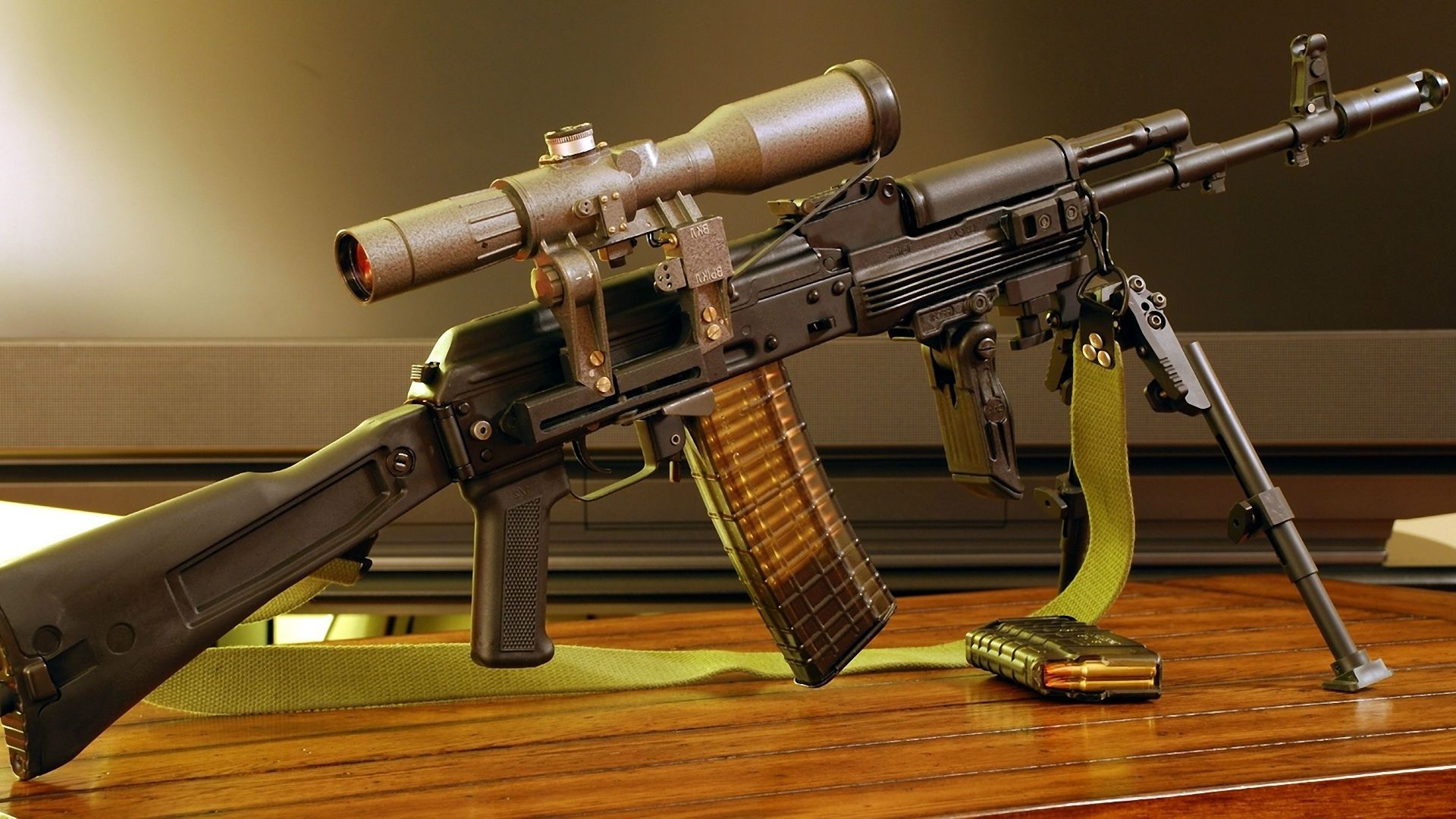
Machine guns have played a prominent role in warfare throughout history, revolutionizing the way battles are fought. These powerful weapons have captured the imagination of people worldwide, becoming synonymous with strength and military prowess. From their inception in the late 19th century to the advanced models of today, machine guns have evolved and adapted to meet the demands of modern warfare.
In this article, we delve into the fascinating world of machine guns and explore 17 intriguing facts that shed light on their history, mechanics, and impact on warfare. Whether you’re a history buff, a weapons enthusiast, or simply curious about the technology behind these iconic firearms, join us as we uncover some lesser-known details about machine guns and the role they’ve played on and off the battlefield.
Key Takeaways:
- Machine guns are powerful automatic firearms that can fire continuously with one trigger pull, shaping the way battles are fought and leaving a mark on military history.
- From the hand-cranked “organ guns” of the Middle Ages to the modern AK-47, machine guns have evolved with advanced optics and materials, continuing to impact warfare with their firepower and innovation.
Machine guns are classified as automatic firearms.
These firearms are designed to fire rounds continuously with one pull of the trigger, as long as there is ammunition and the trigger remains depressed.
The concept of the machine gun dates back to the 14th century.
Early versions of machine guns, such as the hand-cranked “organ guns,” were used in the Middle Ages.
The first true machine gun was invented in the late 19th century.
The Maxim gun, invented by Sir Hiram Maxim in 1884, was the first fully automatic machine gun. It played a crucial role in World War I.
Machine guns are capable of firing hundreds of rounds per minute.
Depending on the model and caliber, machine guns can have a rate of fire ranging from 500 to over 1,000 rounds per minute.
The Gatling gun was a predecessor to the modern machine gun.
Patented by Richard Gatling in 1862, the Gatling gun featured multiple barrels and a hand-cranked mechanism.
Some machine guns use belt-fed ammunition.
In belt-fed machine guns, ammunition is linked together in a continuous belt or chain, which is fed into the firearm as it is fired.
The AK-47 is one of the most widely used machine guns in the world.
Designed by Mikhail Kalashnikov in 1947, the AK-47 is known for its reliability and ease of use. It has been adopted by numerous military forces and militias globally.
The 7.62mm NATO round is commonly used in machine guns.
The 7.62x51mm NATO round has been widely adopted for use in machine guns due to its power and versatility.
The M2 Browning is a .50 caliber machine gun.
The M2 Browning, commonly known as the “Ma Deuce,” is a heavy machine gun chambered for the .50 BMG cartridge.
Machine guns have been used in both offensive and defensive roles.
They have been employed to suppress enemy forces, provide cover fire, and defend strategic positions.
Some machine guns can be mounted on vehicles or aircraft.
Mounted machine guns are commonly found on tanks, helicopters, and other military vehicles to provide firepower support during combat.
The weight of machine guns varies significantly.
Light machine guns, such as the Squad Automatic Weapon (SAW), can weigh around 15 pounds (7 kilograms), while heavier machine guns, like the M2 Browning, can weigh over 80 pounds (36 kilograms).
Machine guns have undergone significant technological advancements.
Modern machine guns often feature advanced optics, recoil compensation systems, and improved ergonomics to enhance accuracy and ease of use.
The effectiveness of machine guns in combat led to the development of body armor.
As machine guns became more prevalent on the battlefield, soldiers sought ways to protect themselves from the rapid and deadly gunfire.
Machine guns are regulated by various laws and treaties.
Many countries have strict regulations on the possession, purchase, and use of machine guns to prevent unauthorized use and maintain public safety.
Machine guns have had a significant impact on the outcome of battles and wars.
Their ability to lay down suppressive fire and engage multiple targets has influenced tactics and strategies employed by military forces.
Machine guns continue to evolve with advances in technology.
New designs, materials, and engineering techniques are constantly being developed to improve the performance and reliability of machine guns.
Machine guns truly epitomize the combination of innovation, firepower, and warfare. They have shaped the way battles are fought and have left an indelible mark on military history.
Remember, machine guns should only be used by trained professionals in authorized situations. Safety is paramount when dealing with these powerful weapons.
Conclusion
Machine guns have a fascinating history and have played a significant role in warfare and self-defense. From their invention in the late 19th century to their modern-day variations, these powerful weapons have had a profound impact on the way wars are fought and tactics employed.
Machine guns are designed to deliver a rapid and continuous stream of bullets, making them highly effective in suppressing enemy forces and providing cover fire. Their awe-inspiring firepower and versatility have made them a staple in militaries around the world.
As technology continues to advance, machine guns are becoming more sophisticated and accurate, with features like long-range capabilities and advanced targeting systems. However, their destructive potential and the moral implications surrounding their use make them a subject of debate and regulation.
Whether you view machine guns as awe-inspiring tools of warfare or dangerous instruments of destruction, there is no denying their significant role in shaping the course of history and modern-day conflicts.
FAQs
Q: When were machine guns first invented?
A: Machine guns were first invented in the late 19th century, with Hiram Maxim receiving a patent for the first fully automatic machine gun in 1883.
Q: How do machine guns work?
A: Machine guns use a combination of mechanical, chemical, and electrical processes to fire a continuous stream of bullets. They harness the energy generated by propellant to cycle the weapon’s mechanisms and feed ammunition into the chamber.
Q: Are machine guns legal for civilians to own?
A: The legality of owning machine guns varies by country and jurisdiction. In some places, they are heavily regulated or banned outright for civilian ownership due to their potential for misuse.
Q: What are some famous machine guns in history?
A: Some famous machine guns include the Browning M2, AK-47, M60, and the Gatling Gun. These weapons have been used in various conflicts and have become iconic symbols of firepower.
Q: How accurate are machine guns?
A: The accuracy of machine guns depends on various factors, including the quality of the weapon, ammunition, and the skill of the operator. Modern machine guns with advanced targeting systems can achieve high levels of accuracy.
Q: What are the advantages of using machine guns in warfare?
A: Machine guns offer several advantages in warfare, including high rates of fire, suppressive fire capabilities, and the ability to maintain fire for extended periods. They can provide cover for advancing troops and create a deterrent effect on enemy forces.
Q: Are there different types of machine guns?
A: Yes, there are different types of machine guns, including light machine guns (LMGs), medium machine guns (MMGs), and heavy machine guns (HMGs). Each type has specific characteristics and is used for different purposes on the battlefield.
Q: How have machine guns influenced military tactics?
A: Machine guns have greatly influenced military tactics by providing superior firepower and the ability to control the battlefield. They have led to changes in infantry tactics, including the introduction of fire and maneuver techniques.
Q: What safety precautions should be taken when handling machine guns?
A: When handling machine guns, strict safety precautions should be followed. This includes proper training, using protective gear, maintaining proper cleaning and maintenance routines, and adhering to all applicable laws and regulations.
Q: Can machine guns be used for self-defense?
A: While machine guns are primarily intended for military use, they are not practical or legal for self-defense purposes for civilians in most jurisdictions. Less-lethal alternatives, such as firearms or non-lethal defense tools, are more appropriate for personal protection.
From the rapid-fire Maxim to the reliable Bren and innovative Hotchkiss, machine guns have left an indelible mark on warfare. Delving deeper into the intricacies of these iconic weapons, you'll find even more captivating facts waiting to be discovered. Uncover the groundbreaking features that made the Maxim a game-changer, explore the Bren's unique adaptability on the battlefield, and marvel at the Hotchkiss's ingenious design. Each machine gun has its own story to tell, filled with fascinating details that will leave you eager to learn more.
Was this page helpful?
Our commitment to delivering trustworthy and engaging content is at the heart of what we do. Each fact on our site is contributed by real users like you, bringing a wealth of diverse insights and information. To ensure the highest standards of accuracy and reliability, our dedicated editors meticulously review each submission. This process guarantees that the facts we share are not only fascinating but also credible. Trust in our commitment to quality and authenticity as you explore and learn with us.


